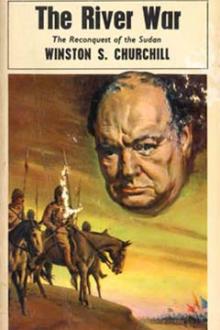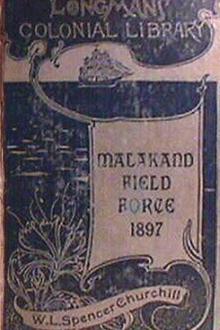The River War by Winston Churchill (spiritual books to read txt) 📕

- Author: Winston Churchill
- Performer: -
Book online «The River War by Winston Churchill (spiritual books to read txt) 📕». Author Winston Churchill
The spectacle of the moving army—the grand army of the Nile—as it advanced towards its goal was especially wonderful in the clear air of the early morning; a long row of great brown masses of infantry and artillery, with a fringe of cavalry dotting the plain for miles in front, with the Camel Corps—chocolate-coloured men on cream-coloured camels—stretching into the desert on the right, and the white gunboats stealing silently up the river on the left, scrutinising the banks with their guns; while far in rear the transport trailed away into the mirage, and far in front the field-glass disclosed the enemy’s patrols. Day after day and hour after hour the advance was maintained. Arrived at the camping-ground, the zeriba had to be built; and this involved a long afternoon of fatigue. In the evening, when the dusty, tired-out squadrons returned, the troopers attended to their horses, and so went to sleep in peace. It was then that the dusty, tired-out infantry provided sentries and pickets, who in a ceaseless succession paced the zeriba and guarded its occupants.
The position of the next camp was a strong one, on a high swell of open ground which afforded a clear field of fire in every direction.
Everyone that night lay down to sleep with a feeling of keen expectancy.
One way or the other all doubts would be settled the next day. The cavalry would ride over the Kerreri Hills, if they were not occupied by the enemy, and right up to the walls of Omdurman. If the Dervishes had any army—
if there was to be any battle—we should know within a few hours.
The telegrams which were despatched that evening were the last to reach England before the event. During the night heavy rain fell, and all the country was drenched. The telegraph-wire had been laid along the ground, as there had been no time to pole it. The sand when dry is a sufficient insulator, but when wet its non-conductivity is destroyed. Hence all communications ceased, and those at home who had husbands, sons, brothers, or friends in the Expeditionary Force were left in an uncertainty as great as that in which we slept—and far more painful.
The long day had tired everyone. Indeed, the whole fortnight since the cavalry convoy had started from the Atbara had been a period of great exertion, and the Lancers, officers and men, were glad to eat a hasty meal, and forget the fatigues of the day, the hardness of the ground, and the anticipations of the morrow in deep sleep. The camp was watched by the infantry, whose labours did not end with the daylight. At two o’clock in the morning the clouds broke in rain and storm. Great blue flashes of lightning lit up the wide expanse of sleeping figures, of crowded animals, and of shelters fluttering in the wind; and from the centre of the camp it was even possible to see for an instant the continuous line of sentries who watched throughout the night with ceaseless vigilance. Nor was this all.
Far away, near the Kerreri Hills, the yellow light of a burning village shot up, unquenched by the rain, and only invisible in the brightest flashes of the lightning. There was war to the southward.
CHAPTER XIV: THE OPERATIONS OF THE FIRST OF SEPTEMBER
The British and Egyptian cavalry, supported by the Camel Corps and Horse Artillery, trotted out rapidly, and soon interposed a distance of eight miles between them and the army. As before, the 21st Lancers were on the left nearest the river, and the Khedivial squadrons curved backwards in a wide half-moon to protect the right flank. Meanwhile the gunboat flotilla was seen to be in motion. The white boats began to ascend the stream leisurely. Yet their array was significant. Hitherto they had moved at long and indefinite intervals—one following perhaps a mile, or even two miles, behind the other. Now a regular distance of about 300
yards was observed. The orders of the cavalry were to reconnoitre Omdurman; of the gunboats to bombard it.
As soon as the squadrons of the 21st Lancers had turned the shoulder of the steep Kerreri Hills, we saw in the distance a yellow-brown pointed dome rising above the blurred horizon. It was the Mahdi’s Tomb, standing in the very heart of Omdurman. From the high ground the field-glass disclosed rows and rows of mud houses, making a dark patch on the brown of the plain. To the left the river, steel-grey in the morning light, forked into two channels, and on the tongue of land between them the gleam of a white building showed among the trees. Before us were the ruins of Khartoum and the confluence of the Blue and White Niles.
A black, solitary hill rose between the Kerreri position and Omdurman.
A long, low ridge running from it concealed the ground beyond. For the rest there was a wide-rolling, sandy plain of great extent, surrounded on three sides by rocky hills and ridges, and patched with coarse, starveling grass or occasional bushes. By the banks of the river which framed the picture on the left stood a straggling mud village, and this, though we did not know it, was to be the field of Omdurman. It was deserted. Not a living creature could be seen. And now there were many who said once and for all that there would be no fight; for here we were arrived at the very walls of Omdurman, and never an enemy to bar our path. Then, with four squadrons looking very tiny on the broad expanse of ground, we moved steadily forward, and at the same time the Egyptian cavalry and the Camel Corps entered the plain several miles further to the west, and they too began to trot across it.
It was about three miles to the last ridge which lay between us and the city. If there was a Dervish army, if there was to be a battle, if the Khalifa would maintain his boast and accept the arbitrament of war, much must be visible from that ridge. We looked over. At first nothing was apparent except the walls and houses of Omdurman and the sandy plain sloping up from the river to distant hills. Then four miles away on our right front emerged a long black line with white spots. It was the enemy.
It seemed to us, as we looked, that there might be 3,000 men behind a high dense zeriba of thorn-bushes. That, said the officers, was better than nothing. It is scarcely necessary to describe our tortuous movements towards the Dervish position. Looking at it now from one point of view, now from another, but always edging nearer, the cavalry slowly approached, and halted in the plain about three miles away—three great serpents of men—the light-coloured one, the 21st Lancers; a much longer and a blacker one, the Egyptian squadrons; a mottled one, the Camel Corps and Horse Artillery. From this distance a clearer view was possible, and we distinguished many horsemen riding about the flanks and front of the broad dark line which crowned the crest of the slope. A few of these rode carelessly towards the squadrons to look at them. They were not apparently acquainted with the long range of the Lee-Metford carbine.
Several troops were dismounted, and at 800 yards fire was made on them.
Two were shot and fell to the ground. Their companions, dismounting, examined them, picked up one, let the other lie, and resumed their ride, without acknowledging the bullets by even an increase of pace.
While this passed, so did the time. It was now nearly eleven o’clock.
Suddenly the whole black line which seemed to be zeriba began to move.
It was made of men, not bushes. Behind it other immense masses and lines of men appeared over the crest; and while we watched, amazed by the wonder of the sight, the whole face of the slope became black with swarming savages. Four miles from end to end, and, as it seemed, in five great divisions, this mighty army advanced—swiftly. The whole side of the hill seemed to move. Between the masses horsemen galloped continually; before them many patrols dotted the plain; above them waved hundreds of banners, and the sun, glinting on many thousand hostile spear-points, spread a sparkling cloud.
It is now known that the Khalifa had succeeded in concentrating at Omdurman an army of more than 60,000 men. He remembered that all the former victories over the Egyptians had been won by the Dervishes attacking.
He knew that in all the recent defeats they had stood on the defensive.
He therefore determined not to oppose the advance at the Shabluka or on the march thence to Omdurman. All was to be staked on the issue of a great battle on the plains of Kerreri. The Mahdi’s prophecy was propitious.
The strength of the Dervish army seemed overwhelming. When the ‘Turks’
arrived, they should be driven into the river. Accordingly the Khalifa had only watched the advance of the Expeditionary Force from Wad Hamed with a patrol of cavalry about 200 strong. On the 30th he was informed that the enemy drew near, and on the 31st he assembled his bodyguard and regular army, with the exception of the men needed for the river batteries, on the Omdurman parade ground. He harangued the leaders; and remained encamped with his troops during the night. The next day all the male population of the city were compelled to join the army in the field, and only the gunners and garrisons on the river-face remained within.
In spite, however, of his utmost vigilance, nearly 6,000 men deserted during the nights of the 31st of August and the 1st of September.
This and the detachments in the forts reduced the force actually engaged in the battle to 52,000 men. The host that now advanced towards the British and Egyptian cavalry was perhaps 4,000 stronger.
Their array was regular and precise, and, facing northeast, stretched for more than four miles from flank to flank. A strong detachment of the mulazemin or guard was extended in front of the centre. Ali-Wad-Helu, with his bright green flag, prolonged the line to the left; and his 5,000
warriors, chiefly of the Degheim and Kenana tribes, soon began to reach out towards the Egyptian cavalry. The centre and main force of the army was composed of the regular troops, formed in squares under Osman Sheikh-ed-Din and Osman Azrak. This great body comprised 12,000 black riflemen and about 13,000 black and Arab spearmen. In their midst rose the large, dark green flag which the Sheikh-ed-Din had adopted to annoy Ali-Wad-Helu, of whose distinctive emblem he was inordinately jealous. The Khalifa with his own bodyguard, about 2,000 strong, followed the centre. In rear of all marched Yakub with the Black Flag and 13,000 men—nearly all swordsmen and spearmen, who with those extended in front of the army constituted the guard. The right





Comments (0)